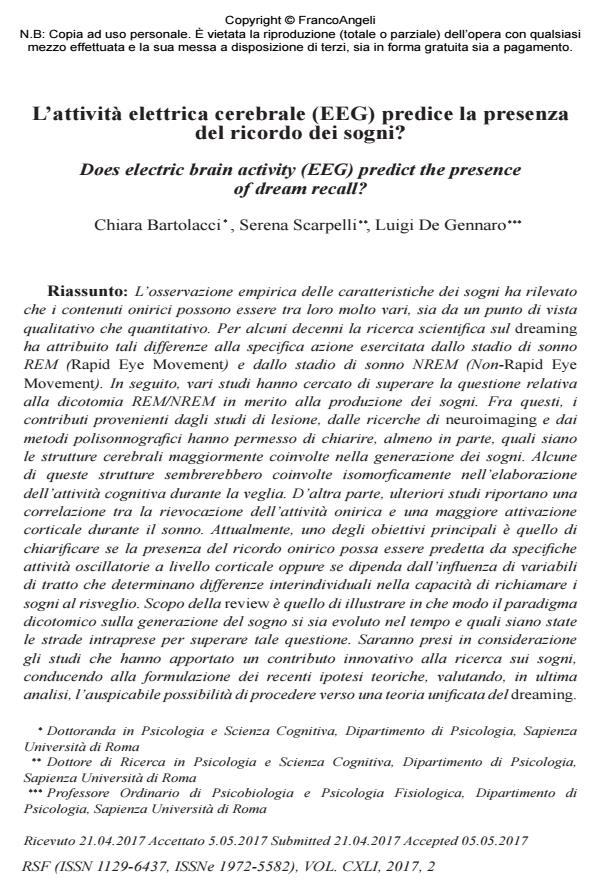Does electric brain activity (EEG) predict the presence of dream recall?
Journal title RIVISTA SPERIMENTALE DI FRENIATRIA
Author/s Chiara Bartolacci, Serena Scarpelli, Luigi De Gennaro
Publishing Year 2017 Issue 2017/2
Language Italian Pages 21 P. 79-99 File size 1816 KB
DOI 10.3280/RSF2017-002005
DOI is like a bar code for intellectual property: to have more infomation
click here
Below, you can see the article first page
If you want to buy this article in PDF format, you can do it, following the instructions to buy download credits

FrancoAngeli is member of Publishers International Linking Association, Inc (PILA), a not-for-profit association which run the CrossRef service enabling links to and from online scholarly content.
Empirical observations of dream characteristics reveal very different contents, both from a qualitative and a quantitative point of view. For a few decades, the scientific study of dreams attributed this variability to the specific action exercised by the two phases of rapid-eye-movement sleep (REM) and non-rapid-eye-movement sleep (NREM). Thereafter, a number of research studies re-examine the REM/NREM dichotomy in dreaming. Lesion studies, among others, using neuroimaging techniques and polysomnographic (PSG) methods start to illustrate which brain areas are more involved in generating dreams. Some of these brain areas seem also to be involved in the elaboration of cognitive activities during wakefulness (using an isomorphic approach). Moreover, further studies underline the correlation existing between dream recall and higher cortical activation during sleep. Nowadays, one of the main aims of research is to clarify whether the presence of dream memories can be predicted by specific oscillatory EEG activities, or derives from trait-like factors which determine inter-individual differences in the ability to recall dreams on awakening. The present review illustrates in what way the dichotomous paradigm on the generation of dreams evolved over time and describes the steps taken to tackle this issue. The authors examine the studies that offer an innovative contribution - to the research on dreams - and formulate the current theoretical hypotheses, considering also, eventually, the auspicious prospect of moving towards a unified theory of dreaming.
Keywords: Dream recall, dreaming, activation, state-like hypothesis, trait-like hypothesis, sleep.
Chiara Bartolacci, Serena Scarpelli, Luigi De Gennaro, L’attività elettrica cerebrale (EEG) predice la presenza del ricordo dei sogni? in "RIVISTA SPERIMENTALE DI FRENIATRIA" 2/2017, pp 79-99, DOI: 10.3280/RSF2017-002005